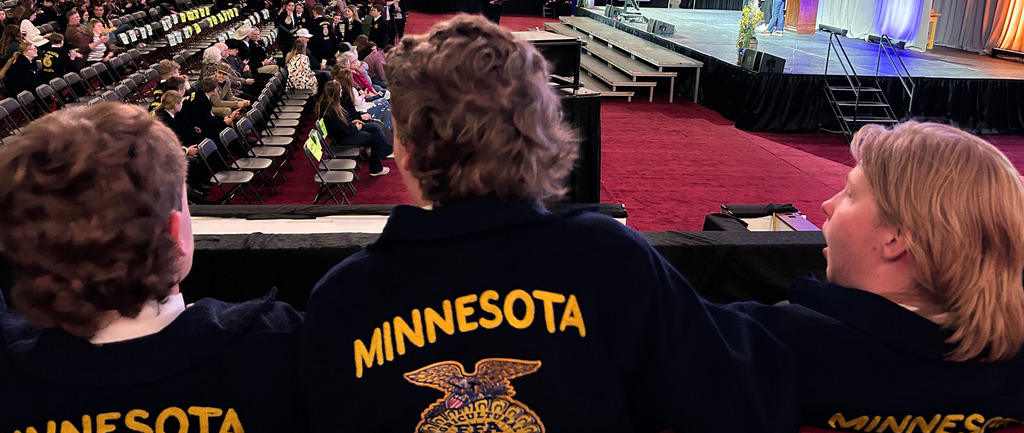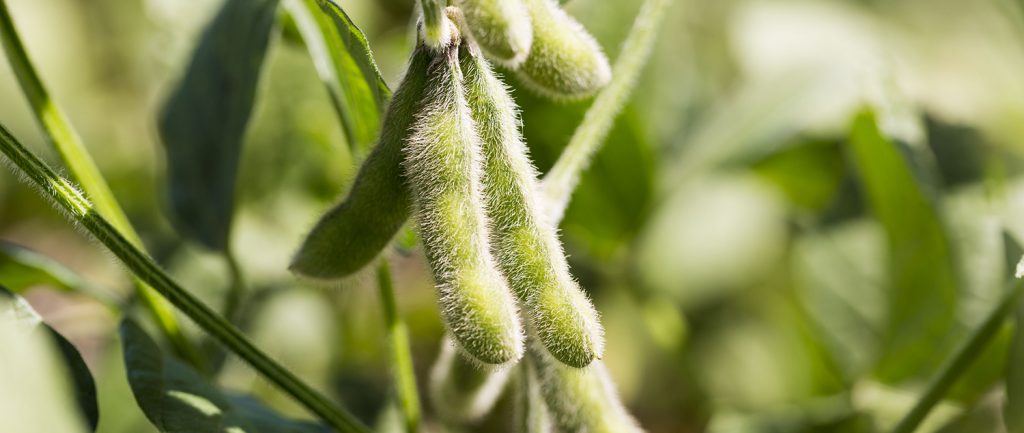This article first appeared in the November-December 2017 issue of Soybean Business. Click here to view the digital version of this issue.
Soybean farmers come in many varieties and stripes. Besides beans, many Minnesota farmers proudly work their land for diverse purposes, growing nontraditional crops. Take a peek at four soybean growers who like to walk on the wild side, where the grass is always greener.
Where the Wild Things Are
What if instead of taking a trip to the zoo, the zoo came to you? At Wild Things Zoo Attractions, that is exactly what the business model is: providing a zoo-style exhibit complete with boulders, ponds, ramps and walk-through pens throughout Minnesota.

“I worked at a zoo in Australia in 2007 and 2008 and it really got me thinking that there were a lot more animals in the world than the 4-H animals I showed at the fair growing up,” says Christian Lilienthal of Wild Things Zoo Attractions.
Lilienthal, who serves on the Sibley County Corn and Soybean Growers board, has more than 50 different species as part of his Wild Things Zoo. Although a wallaby was his first exotic animal purchase after obtaining his zoo keepers license with the United States Department of Agriculture, his first love was actually birds.
“I was really interested in poultry. I gathered a depth of knowledge in chickens, ducks and pigeons as part of a poultry knowledge bowl national competition for 4-H,” Lilienthal says. “I was gifted beautiful pheasants from a family for my birthday one year, and my grandma raised peacocks. Birds just really committed me to learning more about animals.”
Lilienthal, his wife, Gena, and son Lars, farm traditional row crops and raise beef cattle with his parents Bruce and Nelva, and his brother Kevin, near Arlington. Lilienthal acknowledges that without the zoo, he wouldn’t be able to have many of the conversations about modern agriculture that he has had.
“People ask about my background, and that opens the door to talking about our cattle production facility or answering questions about our heard health and our best management practices on our farm,” Lilienthal says. “The animals out in the public view gives me the opportunity to answer those questions.”

The Wild Things Zoo has about 90 engagements per year, and leases animals to zoos such as the Kangaroo Crossing exhibit at the Minnesota Zoo. Although some animals are creatures people may have not seen before, Lilienthal finds the most benefit with bringing animals that parents and grandparents may have familiarity with.
“They can’t share too much about animals they don’t know, but if it is an animal that they are familiar with such as a parrot or an alligator, they can start that conversation with their kids and grandkids. I get to build on that knowledge,” Lilienthal says. “I get to fill in with what I know and can teach a little more about what someone knows like that alligators are cold blooded and they actually age by temperature instead of time.”
The zoo employs around eight people each year in two crews that travel throughout the state setting up complete zoo exhibits.
“Most of our employees are college students pursuing vet science or zoology degrees, and we also have foreign exchange students that work for us,” Lilienthal says. “They receive a skills experience that I’m pretty proud of whether that is driving a truck and trailer for the first time, or a chance to do direct animal care. Even learning to put on a halter or close a gate can be a big deal, and we give that experience to them.”
Much of the focus on their exhibits is around creating interactive exhibits around a certain number of species.
“We don’t provide too much of a petting zoo setting, although some animals can be touched. We spend a lot of time and effort making creative attractions that look nice, while ensuring they are comfortable for the animals,” Lilienthal says. “We can build enclosures 30 feet tall and completely netted so participants have birds flying above them with walkthrough pens. It really is about bringing a zoo like experience to our customers.”
Lilienthal says bringing joy to people who visit Wild Things Zoo is one of the highlights of the operation. He even counts himself in that group.
“Everyone always has some type of fun animal story,” Lilienthal says. “And there are always species I’m surprised to learn about.”
Sticking to the Basics
With a long standing family tradition of growing vegetables and fruits, Tony Kornder continues to grow a plethora of pumpkins for the picking each fall on his farm near Belle Plaine, Minn.

“My grandpa started with gladiolas selling them wholesale and retail, and we had about 70 acres of fruits and vegetables, and the rest of our acreage was corn and soybeans,” Kornder says. “We rented more acres and filled them in with soybeans while our oddball pieces became pumpkins.”
Many challenges in the market had Kornder looking for different crops and livestock on their farm instead of growing vegetables.
“Part of the reason we quit growing a lot of the vegetables is the lack of labor. We just couldn’t find seasonal help. We used to have a crew of 12-15 high school kids, but it got harder to find kids who really want to work,” Kornder says. “Logistics-wise, it became hard to cover four to five stores and be on the road for three to four hours. We just weren’t sure we wanted to get that big.”
The Kornder farm now grows pumpkins for several garden centers, MN Harvest, and several Genesis locations, where Kornder works full time. They also have a U-Pick pumpkin patch each fall.
“My dad, Ted, researches which pumpkin varieties to plant, and we spend a lot of time together in the pumpkin fields,” Kornder says. “When we pick, we actually bulk fill a grain truck and play catch on Sundays. Dad throws, and I catch and stack.”
“Th e U-Pick patch is nice because it is exactly that, I don’t have to pick,” he jokes. “We put it up on Facebook and usually within 10 days we are sold out. We sell straw bales and corn bundles too, all on the honor system with a cash box.”
Kornder’s wife, Wendy, and their children, twins Megan and Adrianna (10), and Ruben (5), also help pick pumpkins in the fall.
“It is a way for us to spend time together. We do a lot of math in the field, counting pumpkins and counting rows. We talk about homework and then finish working on it inside the house.”
The Kornders also raise beef cattle; although they sell in the traditional quarters and halves, they have made a name for themselves with beef sticks and selling direct to restaurants and at farmers markets.
“My dad actually had the beef stick idea. We now have four kinds: maple, German, pepper and jabanero,” Kornder says. “We worked with Odenthal Meats in New Prague, and it was trial and error until we came to a general consensus of holy smokes is it hot, but, boy, does it taste good!”
Kornder has a large walk-in freezer on his farm to store his beef cuts, as well as a traveling trailer he can sell from at events.
“We sell a lot of our beef at Jim’s Apple Barn in Jordan, and we have been selling our steaks, roasts, and chops with Café Carlson at Carlson Towers since 2011,” Kornder says. “We recently started selling at Northwestern College, too.”
Although Kornder can be very busy with working full time as a custom applicator, picking pumpkins, planting and harvesting corn and soybeans, and selling his custom beef cuts, he says putting all his energy into his endeavors brings fulfillment.
“I’m in the house every night. I don’t have to run 2,500 acres, and I don’t have to be a price taker on a lot of my items,” he says. “I was born into this life, so I don’t know how to be anything but busy.”
Wendy Kornder says the fruits of her husband’s labor make the toil worth it.
“It is easy to be supportive because he enjoys it, and there’s something productive at the end whether it’s the pumpkins, the beef, or the crop,” she says.
Grapes of Bruce
Bruce Schmoll has plenty of friends and family who jump at the chance to help him pick his grapes off the vine.
“It’s very labor intensive,” the former Minnesota Soybean Growers Association (MSGA) president says.

The ensuing problem Schmoll encounters is recruiting people who want to continue picking grapes once they realize leisurely stomping on the grapes isn’t involved in the process.
“After they try it once, they’re not so eager to do it a second time,” he says, laughing. “It can be very laborious.”
Schmoll is primarily a corn and soybean farmer from Dodge County, Minn. He and his wife, Tarrie, are also wine aficionados.
It began as a hobby several years ago when the Schmolls started growing grapes on the family farm, with help from a neighbor. Today, they have about 30 vines of mostly red grapes.
“It’s been a learning process,” Schmoll says. “You don’t just plant the vines and let them go – you have to put a trellis system in, you have to prune them, they need to be sprayed. There’s a lot to growing grapes.”
The labor pays off. Schmoll uses the grapes to bottle about 75 bottles of wine each year, and often gift s them to friends and family.
It can be hectic in the fall; depending on the weather, the grapes can mature by late August into September.
“The return can be really good,” he says, “but when they’re ripe, that’s also when we’re ready to get in the field for crunch time.”
Schmoll also grows pumpkins and Black Hills Christmas trees for his grandchildren, and became a pheasant raiser after Minnesota’s pheasant population began to dwindle.
For Schmoll, conservation isn’t just a buzz word. It’s a way of life.
“Too often farmers just focus on getting as much out of the land as they can without giving back,” Schmoll says. “That’s been our emphasis — giving back. At this point, I think we’ve helped out a little bit.”
Green Grass of Home
Drew Parsley farms in two of Minnesota’s most northern counties, Roseau and Lake of the Woods.
“We’re more of a specialty crop area,” he says. “Our fall ends quickly – it’s completely different from southern Minnesota, but we have multiple options.”

In addition to growing soybeans on his 8,000 acre farm, Parsley also raises specialty crops like malting barley, sunflower, canola and wheat.
Diversifying his operation brings rewards, if not riches, Parsley says.
“Even if none of them turn a huge profit margin, it’s always a challenge to dig in to one of them and try to be better at it,” he says. “You don’t get the sameness of trying to make your corn or soybean field perfect. It keeps your mind occupied when you’re always out working and gaining new knowledge.”
Parsley is also a partner in Northern Seed Excellence, a grass seed company based in Williams, Minn. “The grass seed industry has been up in the Lake of the Woods area for 50, 60 years. It’s a cool season crop,” he says. “They typically only grow this quality of grass up here and in the Willamette Valley area near Portland, Oregon. Those are the two areas where we grow this grass, and the temperature and climate have everything to do with why.”
Parsley grows custom turf-quality grass that’s used for baseball and soccer fields, lawns, race tracks and golf courses.
Many times, the variety is named aft er the activity the grass will be used for – i.e. “Goalkeeper” grass for soccer fields.
“The grass seed is perfect for crop rotation, between barley and soybeans,” says Parsley, who operates the family farm with his father, Norvel, and a team of employees. “It’s just a great crop for the rotation.”
Everything is connected in Parsley’s farming world; the same local facilities that cleans his grass also cleans his food grade soybeans.
“We have multiple challenges working with multiple crops,” he says, “but at the end of the day, it’s all worth it.”







